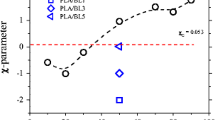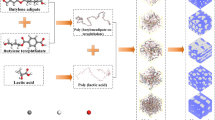Abstract
Computer simulation and experiments were performed to investigate the miscibility of PLA/PEG blends with different PEG concentrations. Flory-Huggins interaction (χ) parameter used to predict the miscibility for the blends was estimated by molecular dynamic simulation of fully atomistic model. The calculated χ parameter and radial distribution function suggest that the PLA and PEG blends are likely miscible at low PEG concentrations (10–30 wt%), but they become apparently immiscible at higher PEG content (>50 wt%). This result is consistent with density distribution of PLA and PEG beads calculated from dissipative particle dynamics simulation of coarse-grained model. To support the computational results, experiments based on differential scanning calorimetry (DSC) and rheometry were also performed. The DSC thermograms of 90:10, 80:20, and 70:30 (wt/wt) of PLA/PEG blends showed a single glass transition and PLA melting peak, indicating PLA/PEG is miscible over this composition. In rheometry, frequency (ω) dependence of storage moduli (G′) at low frequencies for 75:25 and 70:30 blends indicate that these samples are near the phase separation point.







Similar content being viewed by others
References
Auras R, Lim LT, Selke SEM, Tsuji H (2010) Poly(lactic acid): synthesis, structures, properties, processing and applications. Wiley, Canada
Garlotta D (2001) A literature review of poly(lactic acid). J Polym Environ 2(9):63–84
Eguiburu JL, Iruin JJ, Fernandez-Berridi MJ, Roman JS (1998) Blends of amorphous and crystalline polylactides with poly(methyl methacrylate) and poly(methyl acrylate): a miscibility study. Polymer 39:6891
Kulinsky Z, Piorkowska E (2005) Crystallization, structure and properties of plasticized poly(L-lactide). Polymer 46:10290–10300
Ljungberg N, Wesslen B (2002) Tributyl oligomers as plasticizers for poly (lactic acid): thermo-mechanical film properties and aging. Polymer 44:7679–7688
Venkatraman SS, Jie P, Min F, Freddy BYC, Leong-Huat G (2005) Micelle-like nanoparticle of PLA-PEG-PLA triblock copolymer as chemotherapeutic carrier. Int J Pharm 298:219–232
Hu Y, Hu YS, Topolkaraev V, Hiltner A, Baer E (2003) Crystallization and phase separation in blends of high stereoregular poly(lactide) with poly(ethylene glycol). Polymer 44:5681–5689
Lai WC, Liau WB, Lin TT (2004) The effect of end groups of PEG on the crystallization behaviors of binary crystalline polymer blends PEG/PLLA. Polymer 45:3037–3080
Kulinski Z, Piorkowska E, Gadzinowska K, Stasiak M (2006) Plasticization of poly(L-lactide) with poly(propylene glycol). Biomacromolecules 7:2128–2135
Jacobsen S, Fritz HG (1999) Plasticizing polylactide the effect of different plasticizers on the mechanical properties. Polym Eng Sci 39:1303–1310
Pillin I, Montrelay N, Grohen Y (2006) Thermo-mechanical characterization of plasticized PLA: is the miscibility the only significant factor? Polymer 47:4676–4682
Hu Y, Rogunova M, Topolkaraev V, Hiltner A, Baer E (2003) Aging of poly(lactide)/poly(ethylene glycol) blends: part 1. Poly(lactide) with low stereo- regularity. Polymer 44:5701–5710
Kulinski Z, Piorkowska E (2005) Crystallization, structure and properties of plasticized poly(L-lactide). Polymer 46:10290–10300
Sheth M, Kumar RA, Dave E, Gross RA, McCarthy SP (1997) Biodegradable polymer blends of poly (lactic acid) and poly(ethylene glycol). J Appl Polym Sci 66:1495–1505
Younes H, Cohn C (1988) Phase separation in poly(ethylene glycol)/poly(lactic acid) blends. Eur Polym J 8:765–773
Glotzer SC, Paul W (2002) Molecular and mesoscale simulation methods for polymer materials. Annu Rev Mater Res 32:401–436
Jawalkar SS, Adoor SG, Sairam M, Nadagouda MN, Aminabhavi TM (2005) Molecular modeling on the binary blend compatibility of poly(vinyl alcohol) and poly(methyl methacrylate): an atomistic simulation and thermodynamic approach. J Phys Chem B 109:15611–15620
Jawalkar SS, Aminabhavi TM (2006) Molecular modeling simulations and thermodynamic approaches to investigate compatibility/incompatibility of poly(l-lactide) and poly(vinyl alcohol) blends. Polymer 47:8061–8071
Jawalkar SS, Kothapalli VSN, Halligudi SB, Malladi S, Aminabhavi TM (2007) Molecular modeling simulations to predict compatibility of poly(vinyl alcohol) and chitosan blends: a comparison with experiments. J Phys Chem B 111:2431–2439
Mu D, Huang XR, Lu ZY, Sun CC (2008) Computer simulation study on the compatibility of poly(ethylene oxide)/poly(methyl methacrylate) blends. Chem Phys 348:122–129
Gai JG, Li HL, Schrauwen C, Hu GH (2009) Dissipative particle dynamics study on the phase morphologies of the ultrahigh molecular weight polyethylene/polypropylene/poly(ethylene glycol) blends. Polymer 50:336–346
Luo ZL, Jiang JW (2010) Molecular dynamics and dissipative particle dynamics simulations for the miscibility of poly(ethylene oxide)/poly(vinyl chloride) blends. Polymer 51:291–299
Yin Q, Luo JH, Zhou G, Yin QJ, Jiang B (2010) A molecular simulation of the compatibility of chitosan and poly(vinyl pyrrolidone). Mol Simul 36:186–191
de Arenaza IM, Meaurio E, Coto B, Jose-Ramon Sarasua JR (2010) Molecular dynamics modelling for the analysis and prediction of miscibility in polylactide/polyvinilphenol blends. Polymer 51:4431–4438
Fu YZ, Liao LQ, Lan YH, Yang LX, Mei LY, Liu YQ, Hu SQ (2012) Molecular dynamics and mesoscopic dynamics simulations for prediction of miscibility in polypropylene/polyamide-11 blends. J of Mol Structure 1012:113–118
Gu GH, Gu HY, Lang MD (2013) Molecular simulation to predict miscibility and phase separation behavior of chitosan/poly(ϵ-caprolactone) binary blends: a comparison with experiments. Macromol Theory Simul 22:377–384
Fu YZ, Liao LQ, Yang LX, Lan YH, Mei LY, Liu YQ, Hu SQ (2013) Molecular dynamics and dissipative particle dynamics simulations for prediction of miscibility in polyethylene terephthalate/polylactide blends. Mol Simul 39:415–422
Rakkapao N, Visit Vao-soongnern V (2014) Molecular simulation and experimental studies of the miscibility of chitosan/poly(ethylene oxide) blends. J Polym Res 21:606–615
Flory PJ (1989) Statistical mechanics of chain molecules. Hanser, Germany
Theodorou DN, Suter UW (1986) Atomistic modeling of mechanical properties of polymeric glasses. Macromolecules 19:139–154
Meirovitch H (1983) Computer simulation of self-avoiding walks: testing the scanning method. J Chem Phys 79:502
Hoogerbrugge PJ, Koelman JMVA (1992) Simulating microscopic hydrodynamic phenomena with dissipative particle dynamics. Europhys Lett 19:155–160
Groot RD, Warren PB (1997) Dissipative particle dynamics: bridging the gap between atomistic and mesoscopic simulation. The Journal of Chemical Physical 107:4423–4435
Kitade S, Ichikawa A, Imura N, Takahashi Y, Noda I (1997) Rheological properties and domain structures of immiscible polymer blends under steady and oscillatory shear flows. J Rheol 41:1039–1060
Takahashi Y, Ojika Y, Akazawa Y, Takano A, Matsushita Y (2007) Fluctuation effects on viscoelastic properties of Diblock copolymer solutions in disordered state. Polym J 39:509–513
Acknowledgments
The financial support for this work by the Commission on Higher Education, Ministry of Education (Thailand) for supporting the grant fund under the program Strategic Scholarships for Frontier Research Network for the Ph.D. Program is gratefully acknowledged. All molecular simulation works were done at Suranaree University of Technology (SUT), Thailand, and most of the experimental part was performed at Kyushu University, Japan. A.T. and V.V. would like to thank National Nanotechnology Center, Thailand, for their permission to use Material Studio software. V.V. thanks the support of the Advanced Organic Materials Research Group, SUT.
Author information
Authors and Affiliations
Corresponding author
Rights and permissions
About this article
Cite this article
Takhulee, A., Takahashi, Y. & Vao-soongnern, V. Molecular simulation and experimental studies of the miscibility of polylactic acid/polyethylene glycol blends. J Polym Res 24, 8 (2017). https://doi.org/10.1007/s10965-016-1174-3
Received:
Accepted:
Published:
DOI: https://doi.org/10.1007/s10965-016-1174-3




